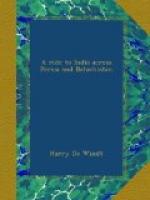The hunting-expedition (the Shagird, who was of a communicative disposition, informed us) consisted of three parties located at villages each within a couple of farsakhs of Murchakhar. Numbering altogether over six hundred men (all mounted), they had been out from Ispahan nearly ten days. Yesterday the prince’s party had been exceptionally lucky, and had had splendid sport. We passed, on the road to Gez, a caravan of fifteen mules laden with the spoil—ibex, deer, wild sheep, and even a wild ass among the slain. The latter had fallen to the governor’s own rifle. There is plenty of sport to be had in Persia, if you only take the trouble to look for it, and in comparative comfort too, with tents, stores, cooking apparatus, etc., if time is no object. The country swarms with wild animals—tiger, bear, and leopard in the forests by the Caspian Sea; wild asses, jackals, and wolves in the desert regions; deer and wild goats in the mountainous districts; and, as we afterwards had uncomfortable proof, lions in the southern provinces. There is no permission needed. A European may shoot over any country he pleases, with the exception of the Shah’s private preserves around Teheran. His Imperial Majesty is very tetchy on this point.
We galloped nearly the whole of the short stage from Gez to Ispahan. A couple of miles out of the city we overtook a donkey ridden by two peasants, heavy men, who challenged us to a trial of speed. We only just beat them by a couple of lengths at the gates, although our horses were fresh and by no means slow. The Persian donkey is unquestionably the best in the East, and is not only speedy, but as strong as a horse. We frequently passed one of these useful beasts carrying a whole family—monsieur, madame, and an unlimited number of bebes—to say nothing of heavy baggage, in one of the queer-looking arrangements (oblong boxes with a canvas covering stretched over a wooden framework) depicted on the next page. An ordinary animal costs from two to three pounds (English), but a white one, the favourite mount of women and priests, will often fetch as much as ten or fifteen.
To reach Djulfa, the Armenian and European quarter of Ispahan, the latter city must be crossed, also the great stone bridge spanning the “Zandarood,” or “Living River,” so called from the supposed excellence of its water for drinking purposes, and its powers of prolonging life. Nearing the bridge, we met a large funeral, evidently that of a person of high position, from the costly shawls which covered the bier.




